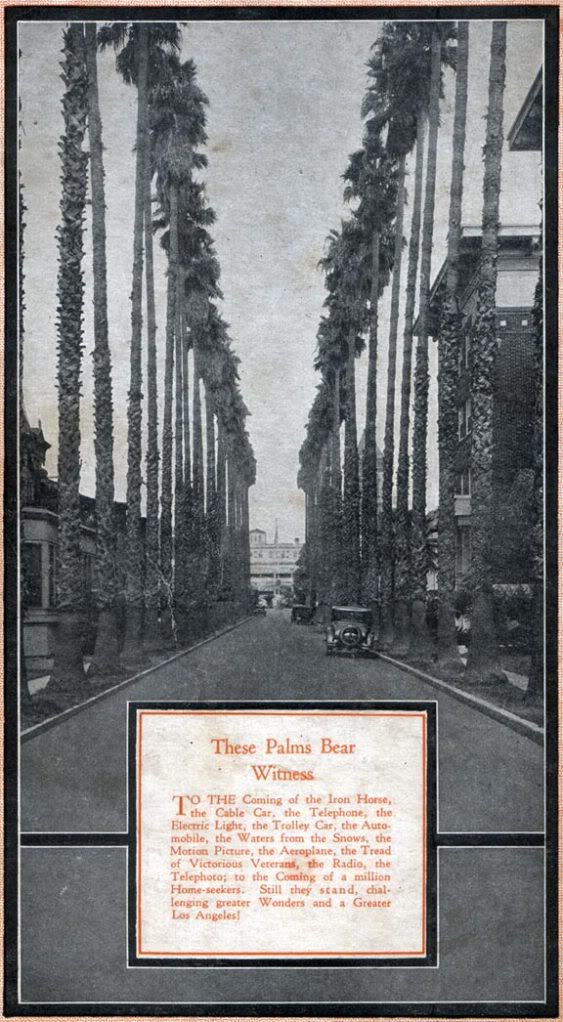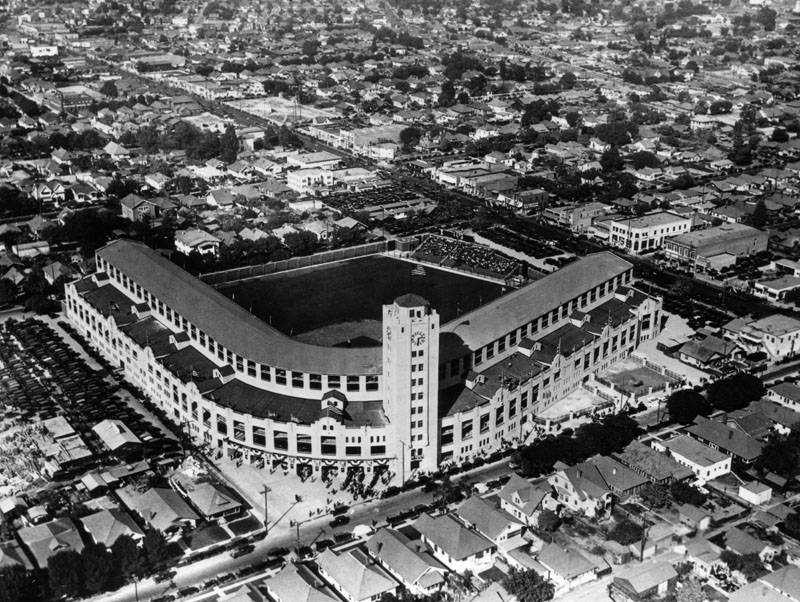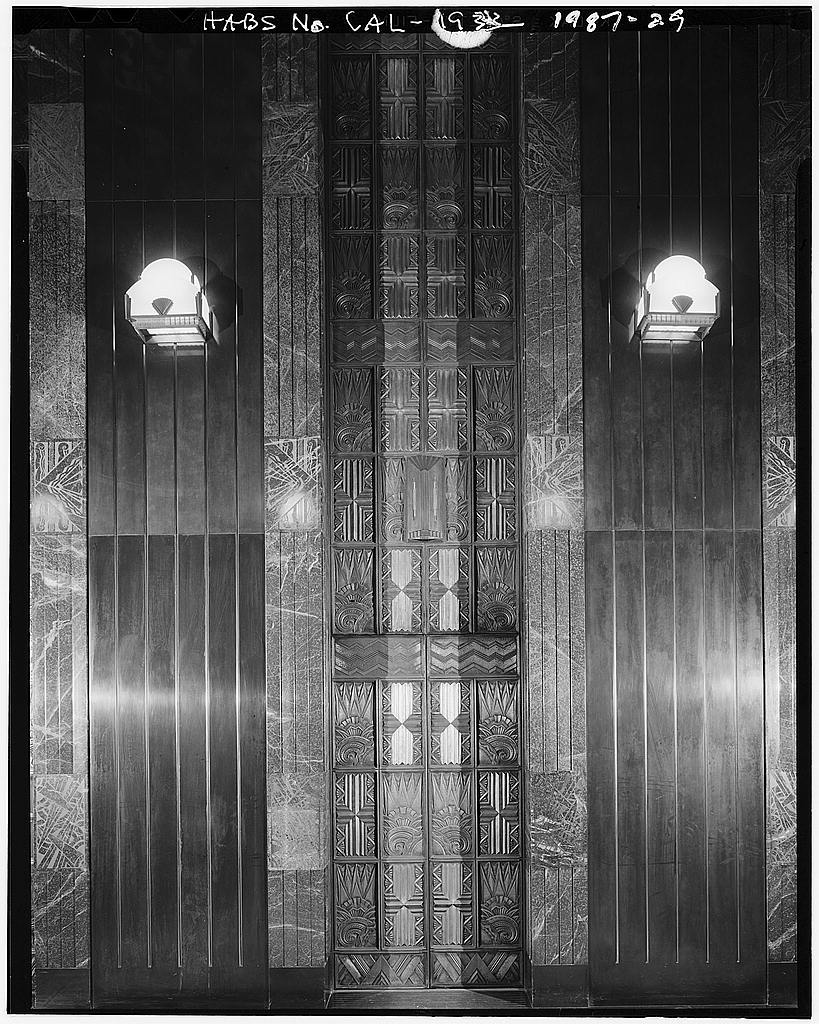EDIT (10/2/2021): Please note that this article contains many statements which, through subsequent research, I discovered are factually incorrect, especially the alleged connection to Confederate General James Longstreet. Click on the "longstreet palms" tag here or at the bottom of the page to read the most recent and accurate findings on this very interesting subject!
It's funny how things that we don't pay any attention to at first can gradually worm their way into our consciousness and eventually become an obsession.
Here's how one such obsession of mine began. As you can tell from my blog, one of my hobbies is collecting
postcards of old Los Angeles; a common subject of which is a "palm drive" or "palm avenue," depicting a street lined usually on both sides with either native or exotic palm trees. Stereotypical California scenes, I thought, of no real noteworthiness. So, I generally ignored these palm-themed postcards – my specialty is downtown street scenes and buildings – but after a while, I started to notice that a lot of the really old palm postcards appeared to depict one specific location: one on or near West Adams Street.

Curious, I looked it up in my 1941 "Hill's Guide" of Los Angeles, and was somewhat surprised to learn that Palm Drive was an actual place.

Then, I went to Google Maps to check the location today. I recognized the area immediately. It's an old memory from my childhood, actually. Palm Drive is located on what is now (or was) the campus of the world-renowned
Orthopaedic Hospital. I
almost stopped my search for the palms at that point, thinking it unlikely they'd still be there. But just on a whim, I decided to have a look at the location with Street View. What I found simply blew me away. Amazingly, the palms still lived!
View Larger Map
Look how tall they are! Given that the early postcards of these palms were from the first decade of the 20th century, this meant they were at least a full century old. Truly remarkable! What I was about to find out, though, is that these palms were, in fact,
much older, and even more remarkably, they had an improbable connection to a well-known figure in American history...

Cutting to the chase: in the course of my research, I uncovered convincing evidence that these two rows of
Washingtonia fan palms could very well be the oldest living things in Los Angeles. They were planted by none other than
Confederate General James Longstreet, about 135 years ago. That may not sound terribly ancient, but to better frame the time perspective,
there are only 4 man-made structures still standing in all of Los Angeles that are older than these palm trees.I compiled the following pictoral history principally by piecing together photos and bits of information I gleaned from two online archives: the
USC Libraries Digital Archive, and the photographic collection of the
Los Angeles Public Library. Now, watch the palms grow through the years!
c.1875: This is the earliest photo of Palm Drive that I've been able to find. ("Early" defined in terms of the height of the trees themselves.) How old are they here, really? There's a house near mine that was built around 1992 that has a
Washingtonia in its front yard that is about as tall as these are below. From that, I infer that these historic palms probably began life around 1860. That would make them
almost 150 years old today. It was from the text accompanying this photo that I learned about the connection to Gen. Longstreet (that's his home at the end of Palm Drive).

Courtesy U.S.C. Digital Library.
1886: More information about Longstreet and his estate: "From a letter to the Herald Express (1940 February 5): 'About 1875, Confederate General Longstreet acquired the 40 acres on the northeast corner of Figueroa and West Adams streets. He did what was possibly up to that time the most extensive grading job done in Los Angeles. He made a pleasing slope up to where the house was to be built, a slope such as we used to read about in southern love stories. He built a mansion of Southern grandeaur [sic] and elegance and made the entrance from West Adams, between the palms which he planted, a southern romance. He planted the whole place with orange trees and it became the showplace of Southern California...'."

Courtesy U.S.C. Digital Library.
c.1900: This scene looks very similar to the photos of Palm Drive in the earliest 20th century postcards (e.g., as above), so even though this photo is undated, around 1900 seems about right.
Here is a photo of General Longstreet's estate's grounds taken around 1890-1900. The caption mentions that the house at this time "was in use as an osteopathic hospital." The website for Orthopaedic Hospital says the clinic was
founded in 1911, but evidently the property's history as a place for treating bone disorders extends back in time to the late 19th century when the property was still owned by Gen. Longstreet himself.

Courtesy Los Angeles Public Library.
c.1910: The referenced page says this photo was taken around 1920, but I guesstimate it was more likely taken closer to 1910.

Courtesy U.S.C. Digital Library.
c.1920: The text accompanying this photo gives the account that, at the time, these were the "tallest palm[s] in the city." Aha! Logically, if these were the tallest, then they were also likely the oldest. The more famous palm-lined avenues of Beverly Hills were just being planted in the late 'teens/early '20s. The trees of Palm Drive were already about 60 years old by then.

Courtesy Los Angeles Public Library.
c.1928: From the back cover of "La Reina - Los Angeles in Three Centuries," published by Security Trust & Savings Bank, 1929. The palms are truly in their prime! General Longstreet's house is gone now, and at right is the Holton Arms, an upscale West Adams "apartment hotel."

c.1940: This is the latest photo I was able find of the historical palms in the online archives. By this time, even before WWII, they had been here for 65 years, and were approximately 80 years old...

Courtesy Los Angeles Public Library.
And it just so happened that while I was beginning to put the finishing touches on my information search, one of my favorite L.A. blogs (Larry Harnisch's
The Daily Mirror) reprinted
a column about General Longstreet's palm trees that had appeared in the
Los Angeles Times 70 years ago, on July 8, 1938:

Click image for source.
Reading this old "Nuestro Pueblo" article was a big thrill, as it provided independent confirmation of many of the factoids I'd found in the USC and LAPL archives, with the happy inclusion of Mrs. Lucy Longstreet's role in the story.

On to the present day... via the web, I've learned that the site of Orthopaedic Hospital was sold in 2006, and that its redevelopment for luxury apartments commenced in 2007. According to
this page, it appears at least some of the ancient palms have already been removed; perhaps all of them are gone now, I don't know. I don't live in the L.A. area, or I would definitely look into this myself.
It would truly be a shame to lose these venerable survivors. I wonder if anyone else but me has any idea just how old or significant these palms really are – that they were planted by a famous Confederate General and his wife, that they were once a celebrated showpiece of Los Angeles, and that today, they might just be the oldest living things in the entire city. Are Gen. Longstreet's palms really gone? I sincerely hope not...
Read the next installment in the saga of the Longstreet Palms: 'Whose palms are these, anyway?'

An 1899 postcard featuring "Palm Avenue."















































